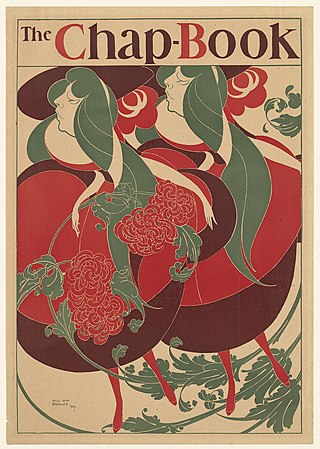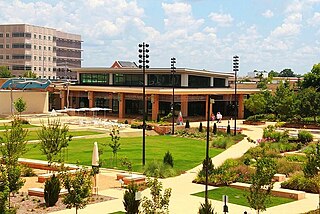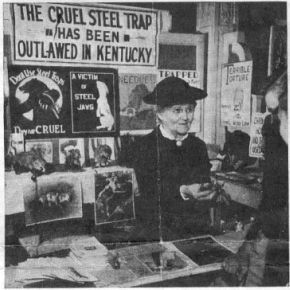
In the United States, a little magazine is a magazine genre consisting of "artistic work which for reasons of commercial expediency is not acceptable to the money-minded periodicals or presses", according to a 1942 study by Frederick J. Hoffman, a professor of English. While George Plimpton disagreed with the diminutive connotations of "little", the name "little magazine" is widely accepted for such magazines. A little magazine is not necessarily a literary magazine, because while the majority of such magazines are literary in nature, containing poetry and fiction, a significant proportion of such magazines are not. Some have encompassed the full range of the arts, and others have grown from zine roots.

Southern United States literature consists of American literature written about the Southern United States or by writers from the region. Literature written about the American South first began during the colonial era, and developed significantly during and after the period of slavery in the United States. Traditional historiography of Southern United States literature emphasized a unifying history of the region; the significance of family in the South's culture, a sense of community and the role of the individual, justice, the dominance of Christianity and the positive and negative impacts of religion, racial tensions, social class and the usage of local dialects. However, in recent decades, the scholarship of the New Southern Studies has decentralized these conventional tropes in favor of a more geographically, politically, and ideologically expansive "South" or "Souths".

The Spirit of the Times: A Chronicle of the Turf, Agriculture, Field Sports, Literature and the Stage was an American weekly newspaper published in New York City. The paper aimed for an upper-class readership made up largely of sportsmen. The Spirit also included humorous material, much of it based on experience of settlers near the southwestern frontier. Theatre news was a third important component. The Spirit had an average circulation of about 22,000, with a peak of about 40,000 subscribers.

Southern Literary Journal (SLJ) was established in 1968 by editors Louis D. Rubin, Jr. and C. Hugh Holman. In 2015 the journal changed focus from literary to interdisciplinary content, changed its name to south, and became more closely related to UNC Press. It is published by the University of North Carolina Press biannually.
The Mississippi Quarterly: The Journal of Southern Cultures is a peer-reviewed scholarly journal that mainly covers Southern history and literature. Originally entitled Social Sciences Bulletin, it was established in 1948 by John K. Bettersworth, who was associated with the journal until his death in 1991. While it began with a very wide focus, initially covering a variety of topics that fell under the umbrella of the social sciences, starting in 1953 the Bulletin gradually narrowed its academic range. Changing its title to its current state in that same year, the newly christened Quarterly soon began to focus almost solely on Southern literature. In 1968 it adopted its current subtitle, further cementing its reputation as a humanities journal. In that year it also began its cooperation with the Society for the Study of Southern Literature through which was produced the "Annual Checklist of Scholarship in Southern Literature". Its editors have included Robert B. Holland, Scott C. Osborn, Peyton W. Williams, Jr., Robert L. Phillipps, Jr., and Noel Polk. Its current editor is Ted Atkinson and its Associate and Managing editors are Robert M. West and Laura West respectively.

The Mississippi Museum of Art is a public museum in Jackson, Mississippi. It is the largest museum in Mississippi.
John Kelly Fitzpatrick (1888–1953) was a regionalist American painter from Alabama.

Lucy S. Furman was an American novelist, short story writer, and animal welfare activist. Her fiction was a foundational influence on what would become Appalachian literature.
Judith Lomax was an American poet and religious writer. She was the first woman in Virginia to publish a volume of poetry entirely her own.
The literature of West Virginia, U.S.A., includes fiction, poetry, and nonfiction. Representative writers include Pearl S. Buck, Rebecca Harding Davis, Keith Maillard and Melville Davisson Post.
The literature of Georgia, United States, includes fiction, poetry, and nonfiction. Representative writers include Erskine Caldwell, Carson McCullers, Margaret Mitchell, Flannery O’Connor, Charles Henry Smith, and Alice Walker.
The literature of Louisiana, United States, includes fiction, poetry, and nonfiction. Representative authors include Kate Chopin, Alcée Fortier, Ernest Gaines, Walker Percy, Anne Rice and John Kennedy Toole.
The literature of South Carolina, United States, includes fiction, poetry, and nonfiction. Representative authors include Dorothy Allison, Daniel Payne and William Gilmore Simms.
The literature of Maryland, United States, includes fiction, poetry, and nonfiction. Representative authors include John Barth, H. L. Mencken, and Edgar Allan Poe.
The Richmond German Christmas Dance is an annual ball held during the Christmas season at The Commonwealth Club in Richmond, Virginia. Founded in 1866, shortly after the end of the American Civil War, it is the oldest debutante ball in Virginia.
South Atlantic was an American magazine published from 1877 to 1882. It was edited by Carrie Jenkins Harris. It started in Wilmington, North Carolina, and then moved to Baltimore.
The South Atlantic Quarterly is an American little magazine founded by John Spencer Bassett, a history professor at Trinity College, in 1901. The magazine published articles about on southern history and, following the example of the Sewanee Review, also tackled topics dealing with the issue of race in the South.

Annie Somers Gilchrist was a pioneer woman author of Tennessee during the long nineteenth century who wrote novels, poetry, and biographies. As a novelist, she was best known by the popular novels: Rosehurst, Harcourt, and The Mystery of Beechcroft. Her poems were numerous. She was also an excellent musician and elocutionist.
Maie Dove Day was an American author and poet in post-Civil War Virginia.






